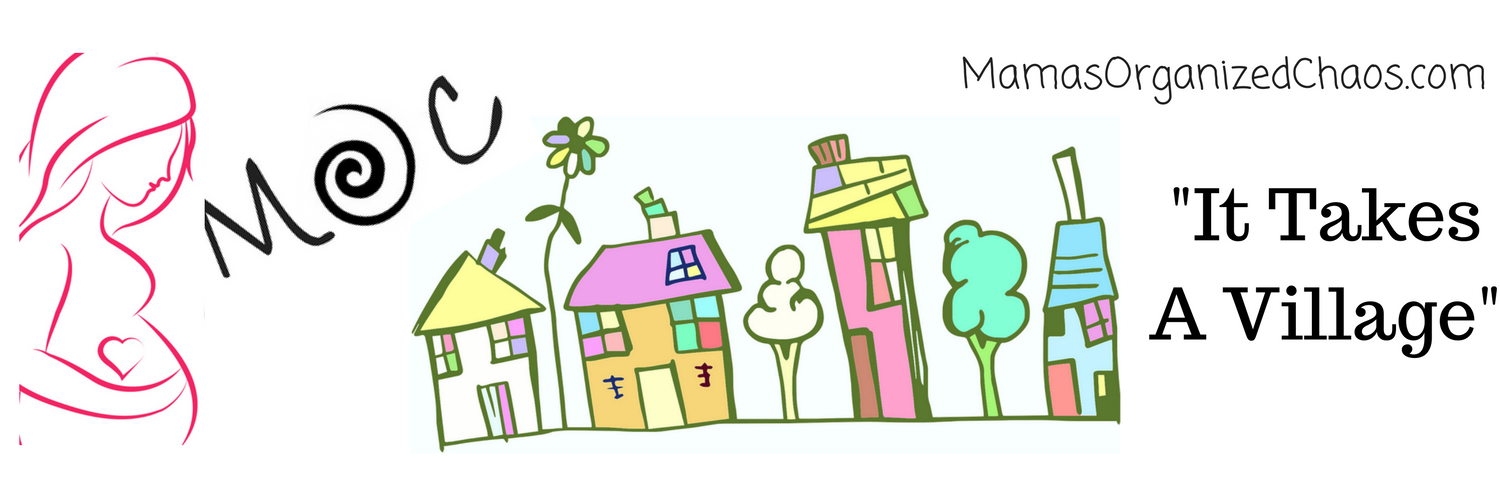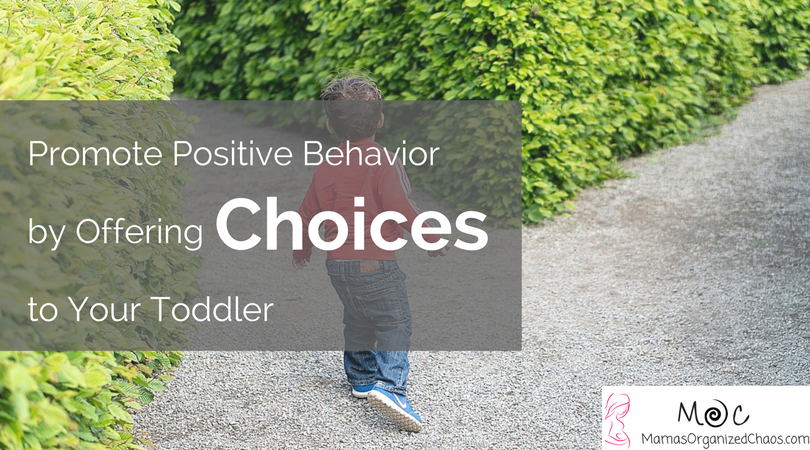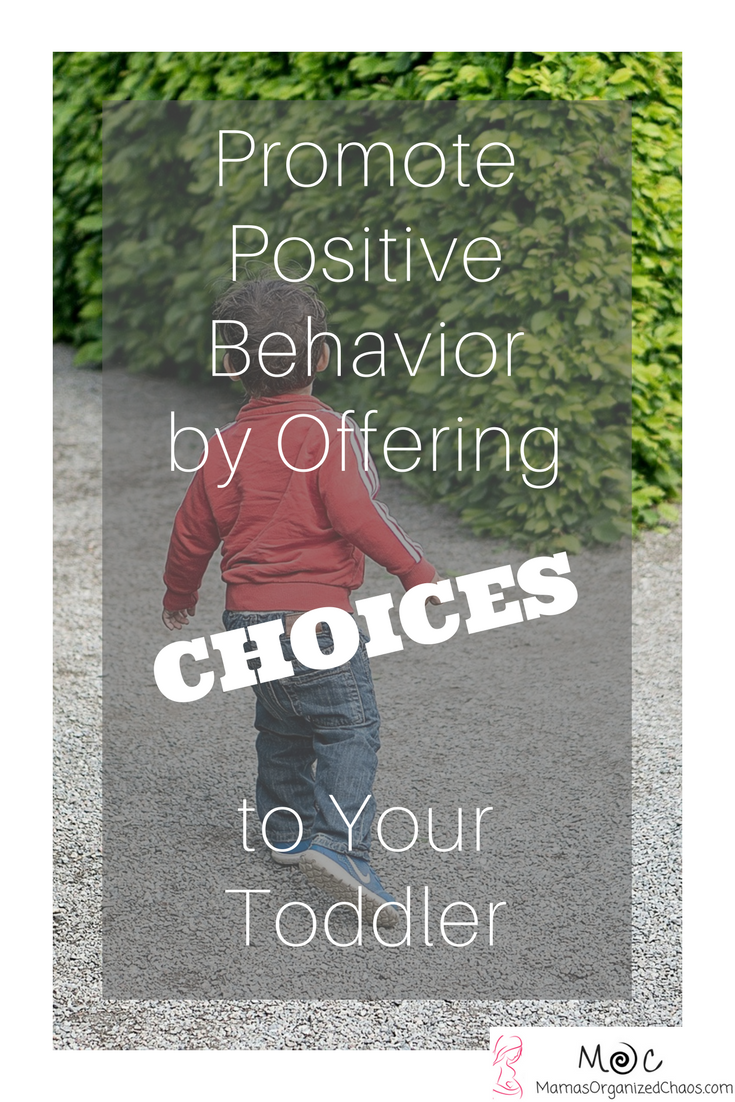Today is a very special day! I’ve linked up with another blogger as a part of a new collaborative blogging group. We have both decided to write on the subject of “toddler behaviors”! Check out Carolyn’s blog post today as well: – When Your Child Is An Extrovert And You’re Not.
Promoting Positive Behavior by Offering Choices to Your Toddler
Choices. They fuel our world. As adults we thrive on making choices and wouldn’t have it any other way. Can you imagine a world where you didn’t get to make choices? You’d go out to dinner and just be handed a meal and told take it or leave it. Perhaps you don’t even get to choose how much you want to eat. You might be full, but you are told you need to keep eating- you don’t have a choice. You’d go to purchase a car and the “expert” would choose for you. Our lives are what they are because of the choices we’ve made. We got to choose what we majored in at college. We got to choose what companies we wanted to apply to and work for, and on and on. Even down to the little choices we make each day- what glass to use for our drink, what shoes to put on, how we want our hair styled, etc. These choices make us feel a sense of ownership and pride in ourselves. These choices make us who we are and make life interesting.
Now think about your toddler. Maybe you have a young toddler that isn’t able to communicate with words yet. Maybe you have a toddler that has a whole slew of words and babbles all day. In either case, they have an opinion. The young toddler has frustrating moments because they can’t even express what they want, much less get what they want. The older toddler has frustrating moments because they are saying what they want and still not getting what they want. Toddlers like to make choices just like we do, and if you think about a toddler’s day, they are constantly being told what to do and how to do it. Don’t get me wrong, they need boundaries and consistency. Without this, they’d be a hot mess. Structure is well needed and does a toddler good. Choices, however, can also be a very positive addition to your child’s life, and can even help to promote an overall sense of positive behavior throughout the day.
Why offer choices
– Avoid Power struggles: Anything you can do to avoid a power struggle with your toddler (which so often results in a tantrum) is going to be beneficial for everyone. Toddlers are still learning how to control their emotions. Power struggles create situations where everyone gets frustrated (child and parents), and they rarely resolve seamlessly. In a power struggle, the desired behavior is typically not the outcome that is gained, and the parent ends up punishing or giving threats that they don’t want to act upon. When a choice is offered, power struggles are minimized drastically.
– Thinking opportunities: When a choice is offered to your child, they have to think about their selection. Providing thinking opportunities throughout your day is obviously beneficial to their education and problem solving abilities. It also provides calmness. Rarely are people going to act out in frustration when they are thinking.
– Sense of control: Your toddler gets to determine the outcome of a situation. They get to choose from the choices you’ve provided! This gives them a sense of control. Having a sense of control is going to make them involved in the process, and they will feel good about their involvement.
– Ownership: When a child is involved in making choices, they feel a sense of ownership. They are more likely to complete the task asked of them now that they feel a sense of ownership. They will feel proud and happy to have this ownership.
– Children feel trusted: Children notice when we trust them to make the right decision. When children feel trusted, they not only reciprocate that trust, they are more likely to behave well and respect the choices that are given to them.
When to offer choices
Choices can be used in most situations! The only time it is not a good idea to use choices, is when a child’s safety is involved and you don’t have the time to ensure your child is safe while providing the choices. Here are a few examples of choices that can be given throughout the day:
– Walking from the parking lot into a store. Maybe you know from experience that your child will refuse to hold your hand and try to run off. Instead of waiting for this power struggle to occur, before you get out of the car, you can offer your child a choice:
- “Caroline, when we are walking in the parking lot we need to be safe. I need you to either hold Mama’s hand, or be carried. Which would you prefer? Do you want Mama to carry you, or would you rather hold my hand?”
Even if you are in the middle of a power struggle with your child, you can offer these choices. Once you make sure your child is safe and not running off, you can offer the same choices as above. Typically it will diffuse the situation and your toddler will pick an option.
– It’s bedtime and you need your toddler to clean up and head to the bathroom to get ready for bed. This is often a time of frustration for parents, because their child does not want to go to bed and resists. Instead of informing your child it’s bedtime and telling them to clean up, you can take a choice approach:
- “Caroline, it’s almost time for bed and we need to clean up. Would you rather clean up the blocks first, or the cars?”
You can continue the choices while getting ready for bed:
- “Caroline, do you want to go potty first, or brush your teeth?”, “Do you want the bird pull up on, or the flower pull up?”, “Which color of floss stick would you like? Yellow or orange?”, etc.
Once done in the bathroom the choices can continue:
- We like to lay out 3 books and ask her to choose which book we read. This takes less time than her getting to choose from ALL of her books.
- “Are you going to get up in bed by yourself, or do you want Mama to help you?”
– At the table, if your child is refusing to eat or upset about how you cut the sandwich, etc. You can also diffuse with choices:
- “Caroline, will you be eating your sandwich first, or your blueberries?”
- “It’s time to drink some water, are you going to take 2 big drinks or 3 big drinks?”
– Let’s say you are at a playdate and your child takes a toy from another child. You can still offer choices!
- “Caroline, Emily was playing with that toy. You need to return it and say you are sorry. “Do you want to say you are sorry first, or return the toy first?”. Then you can continue to help your toddler through the process.
– Your child asks you if they can do something, and your answer is no. Don’t change your answer, but do offer a choice:
- Caroline asks to go for a walk. We don’t have time or it’s too cold. I take the time to explain these reasons to her, but also give her some options as to what we can do right now. “Caroline, thank you for asking nicely, but it’s too cold to go on a walk right now. Right now we can either do table time or puzzles. Which would you like to do? Table time or puzzles?”
The possibilities with choices are ENDLESS! You can see it is a much more neutral approach and is less likely to upset your child. There is a common theme with all of the choices given. Did you find it?
How to offer choices
Did you figure out the common theme yet? No worries if you haven’t. It’s obvious once you know what it is: every choice, every option provided, is a result that the parent wants! Your child will think they have the control that they desire, but they have no idea that you’ve pre-selected choices that work for YOU. It’s win-win for you no matter which option they choose. This is a MUST in order to be successful!
So, here’s the how to of offering choices:
1. Make sure you are happy with all outcomes– Never offer a choice that you aren’t happy with.
2. Try and prepare your child ahead of time- If your child is already upset, choices can help diffuse. Even better than this, however, is anticipating when your child might get upset and offering the choices ahead of time. If you do this often enough, it will become a part of your natural language and interaction with your child. You’ll find yourself thinking 10 steps ahead!
3. Enforce a “you choose or I’ll choose” rule- If your toddler decides that she doesn’t want either choice, the next step is to offer another choice. “You can choose, or Mama is going to choose”. My daughter has flat out said “Mama choose.” That’s fine! I’m choosing from the same options and we are ending with the same outcome. If this choice makes them upset, just choose and make sure you follow through with that choice happening. This might literally mean picking your child up to set them by the blocks that they need to clean up.
4. Praise your child for being involved- When your child makes a choice and does something well, praise them! Make sure they know that you noticed! “Caroline you are doing such a great job holding Mama’s hand!”, “Caroline thank you so much for cleaning up your toys, you did a really good job!”, etc., etc., etc.! The more they hear your praise, the more they’ll want to do those specific things again.
What to do when the choice method doesn’t work
This method by no means creates a perfect world. After all, we are dealing with toddlers here! There will still be struggles, there will still be stand offs, there will still be tears and lot’s of saying “no”. The good news is that these moments will be incredibly minimized if you choose to employ choices throughout your day. For the times that choices aren’t working, here are a few things you can do to help the situation:
– Natural consequences: When consequences are needed, try to use natural consequences instead of punishment. Natural consequences are a great alternative to simply enforcing a punishment. If you find a true natural consequence, the consequence makes sense, naturally happens as a result of the unwanted behavior, and will consistently happen every time the behavior happens. This post has examples of natural consequences for different ages.
– Help your child to calm down: It’s ok to offer a hug and provide some methods for calming down (deep breaths, squeezing their hands together, etc.)
– Show empathy: Everyone needs to feel heard. If your toddler is upset, while it might seem silly to you, it is HUGE to them. Toddlers can have their world shifted upside down by seemingly “trivial” things. You don’t have to understand why it is making them so upset, but you do need to try and relate. It is hard when you don’t get what you want. Explain to your child that you know how they are feeling- you know it can be frustrating, etc.
Other posts of interest:
A page on “Behaviors” (all posts related to teaching behaviors, correcting behaviors, and discipline)
Includes posts on positive reinforcement, tantrums, and more!
Transitioning Your Focus to Positive Behavior & Natural Consequences
2 Tips That Stop Tantrums Immediately (Caroline was 21 months old)
Benefits of Consistency: Saying NO
Oh the Fits – 6 Things to Keep In Mind When Tantrums Start
 |
| Click here to join the MOC Village |
?Don’t forget to leave a comment below! I love hearing from readers! Tell me what you thought of the post, share your experiences, and even drop a topic idea down for me!


